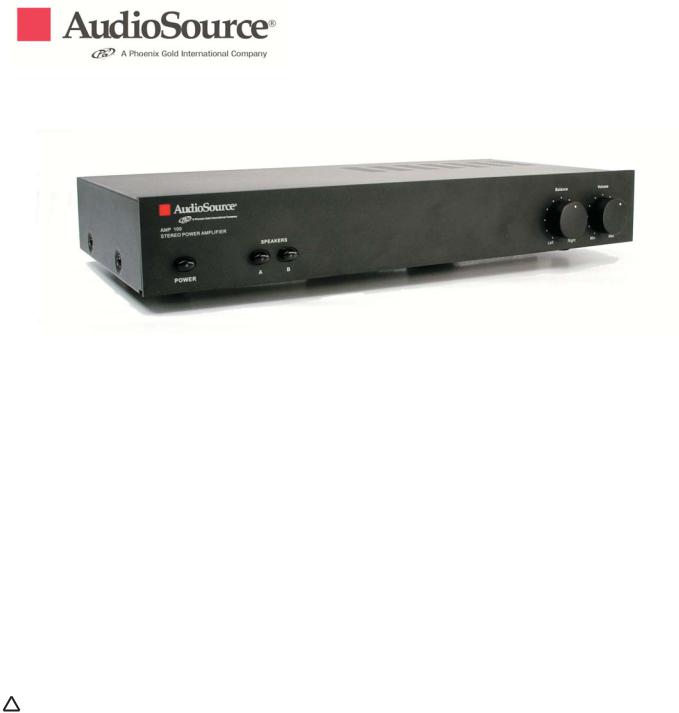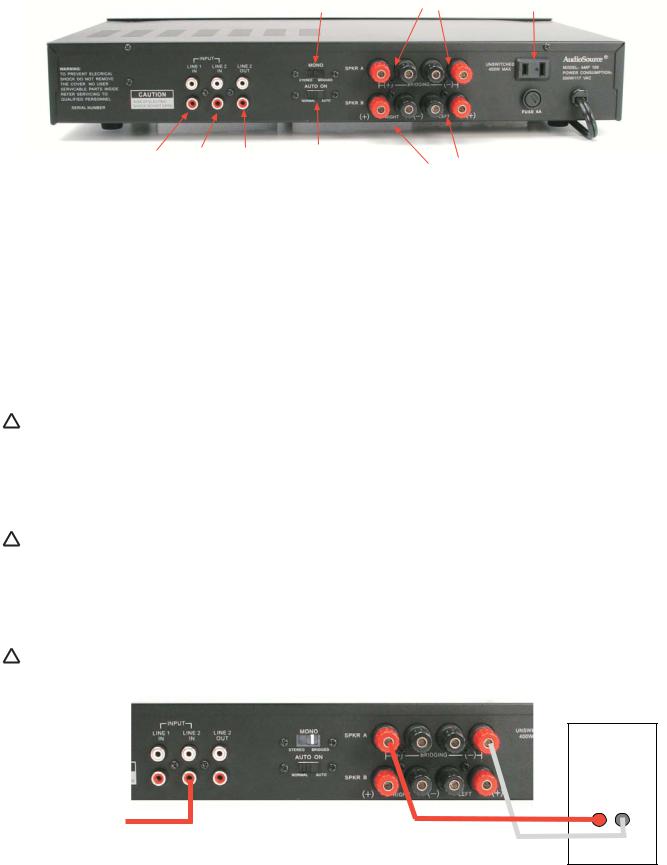AudioSource AMP 100 User Manual

AMP 100 User Manual
2 Channel Amplifier
With Auto Switching Dual Inputs
General Features and Specifications
 Heavy Duty Black Aluminum Faceplate
Heavy Duty Black Aluminum Faceplate
 160W Max Power Amplifier
160W Max Power Amplifier
 Power Consumption 500W
Power Consumption 500W
 2 Pair Stereo Inputs
2 Pair Stereo Inputs
 1 Pair Stereo Outputs
1 Pair Stereo Outputs
 Auto On (Signal Sensing)
Auto On (Signal Sensing)
 Auto Input Switching
Auto Input Switching
 A, B, A+B Speaker Selector Switches
A, B, A+B Speaker Selector Switches
 5-Way Speaker Binding Posts
5-Way Speaker Binding Posts
 Unswitched 400W Power Outlet
Unswitched 400W Power Outlet
 User Serviceable Fuse (T4A / 250V)
User Serviceable Fuse (T4A / 250V)
 Bridgeable Outputs
Bridgeable Outputs
 Rubber Vibration-Damping Feet
Rubber Vibration-Damping Feet
 Net Weight: 9.6 lbs (21.1 kg)
Net Weight: 9.6 lbs (21.1 kg)
 Dimensions: 2.9” H x 16.5” W x 9.25” D (74mm x 419mm x 235mm)
Dimensions: 2.9” H x 16.5” W x 9.25” D (74mm x 419mm x 235mm)
Congratulations on your purchase of the AudioSource AMP100 amplifier. We trust that you will enjoy the value and quality of your AudioSource AMP100 for many years. Please take a few moments to read this manual and retain it for your reference.
AMP100 Overview
The AudioSource AMP100 represents the very latest in affordable state of the art in amplifier design. Featuring dual inputs, its inputs are signal sensing, which means that the amp can be configured to turn on automatically when music is sensed on the input RCA’s. Input one will override input two whenever signal is present. This makes the AMP100 the perfect amplifier as a zone amplifier for multiroom distribution systems. Any time a local source is activated, it will take priority over the whole house audio by simply showing signal present at input one of the AMP100. Also, use the AMP100 as amplification for your computer or video games. The AMP100 also has two pair of speaker outputs to allow the amp to run a main, or ‘A’ pair of speakers, as well as an auxiliary, or ‘B’ pair of speakers and allows selection of either, or both, from the front panel of the amplifier.
!Note: When using A & B speaker together it is imperative that the speaker systems all be a minimum 8-ohm impedance.
Technical Specifications
8 ohm Input Sensitivity to Achieve 50W with THD+N less than 0.02%: 1.4V RMS 4 ohm Input Sensitivity to Achieve 75W with THD+N less than 0.02%: 1.2V RMS Maximum 8 ohm stereo output power at 1% THD+N: 60W
Maximum 4 ohm stereo output power at 1% THD+N: 75W Maximum 8 ohm Bridged-Mono output at 1% THD+N: 160W
(These specifications were measured with a 1kHz Sine Wave applied to both channels, and both channels driven)
Frequency Response: +1dB, -0.5dB |
|
8 ohm, Stereo Power Bandwidth: |
50W @ 8 ohms, <1% THD+N, 20-20kHz |
4 ohm, Stereo Power Bandwidth: |
60W @ 4 ohms, <1% THD+N, 20-20kHz |

Stereo / Bridged |
“A” Speakers |
Unswitched |
Switch |
|
AC Outlet |
Line 1 |
Line 2 |
Line |
Signal Sensing |
“B” Speakers |
Input |
Input |
Output |
Auto-On |
|
|
|
|
Figure1 |
|
Connections on the Rear Panel
Line Input 1 is used to connect a local source such as CD Player, Computer Sound Card, Television Audio Output or other line level source. Line Input 1 has “Priority” over Line Input 2 and will override Line Input 2 whenever signal is present at the inputs marked Line 1.
Line Input 2 is used to connect a signal such as a whole house audio signal as long as it is at line input levels, not speaker level. This can be any source the user wants to have as a primary source.
Line Output 2 is a pass through output of the signal at Line Input 2. Although Line 2 may be overridden by Line 1, its signal is always present at Line Output 2 to be passed on to another zone or location as a line level signal.
Bridging Switch (refer to wiring diagram Figure 2)
In addition to providing 60 watts RMS per channel in the stereo mode, your Amp100 can be used as a high power mono amplifier, providing over 160 watts RMS. This can be accomplished by sliding the mono switch from the stereo position to the bridged position. For mono applications, use only the right channel input.
! Note: Be sure to observe the correct speaker connections for bridged applications. Because of the high power output in this mode, we recommend initially setting the volume control at ‘min’, and then adjusting the volume to the desired level.
Auto On Switch
The Amp100 can be configured to power on automatically, or to have manual control. If you would like the amp to come on automatically when the source begins sending signal, put the auto on switch in the “AUTO” position. When using the amplifier in the “Auto ON” mode the amplifier will automatically shut down after a period of time without signal present. If you would prefer to use the power button on the front of the amplifier, put the auto on switch in the “NORMAL” position.
! Note: If someone switches the amplifier off by using the power button on the front of the amplifier, the auto on feature will not work until the unit is manually switched on again by pressing the power button on the front of the amplifier.
Speaker Terminals
More than one pair of speakers can be used with the Amp100. We have provided two pairs of speaker outputs, labeled SPKR A (left & right) and SPKR B (left & right). The speaker terminals are color coded. Red posts indicate positive (+) terminals and black posts indicate negative (-) terminals. Be sure to connect the positive output terminals of your Amp100 to the positive input terminals of your speakers and the negative output terminals of your Amp100 to the negative input terminals of your speakers.
! Note: Refer to the wiring diagrams on the next page for proper connection of speaker cables.
MONO Source |
Figure 2 |
+ _ |
|
||
|
|
